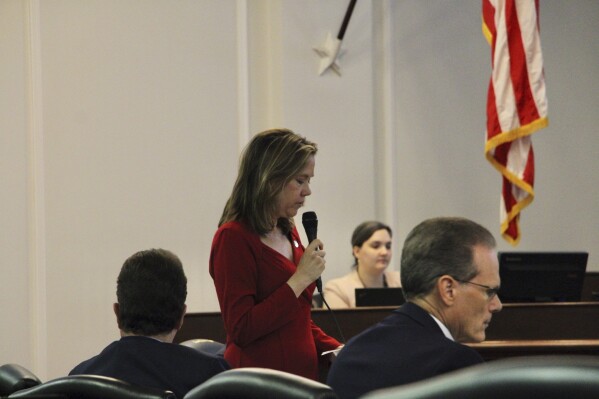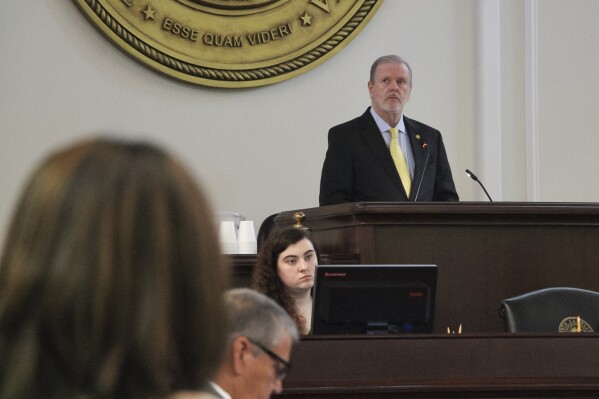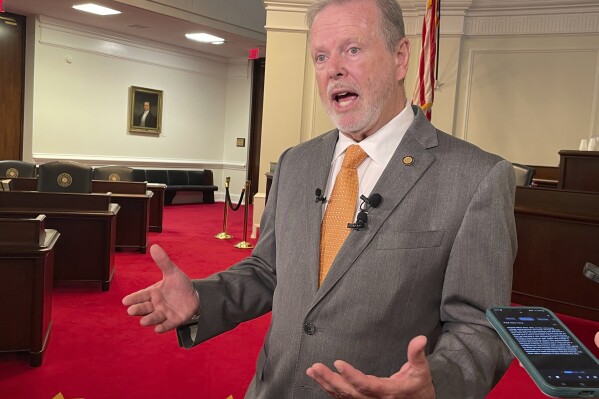Tropical Storm Ophelia forecast to make landfall early Saturday on North Carolina coast
ANNAPOLIS, Md. (AP) — Tropical Storm Ophelia was expected to make landfall on the North Carolina coast early Saturday morning with the potential for damaging winds and dangerous surges of water, the U.S. National Hurricane Center said.
Life-threatening flooding caused by the weather system was forecast for parts of eastern North Carolina and southeastern Virginia, the center said in an update at 11 p.m. Friday.
Ophelia was about 70 miles (115 kilometers) south of Cape Lookout, North Carolina, and heading north-northwest at 12 mph (19 kph) late Friday after spinning into tropical storm during the afternoon.
The system had maximum sustained winds of 70 mph (113 kph) with some higher gusts, but was forecast to weaken after landfall, the hurricane center reported.
 North Carolina legislature cracks down on pornography sites with new age verification requirements
North Carolina legislature cracks down on pornography sites with new age verification requirements
 North Carolina legislature gives final OK to election board changes, with governor’s veto to follow
North Carolina legislature gives final OK to election board changes, with governor’s veto to follow
 Medicaid expansion to begin soon in North Carolina as governor decides to let budget bill become law
Medicaid expansion to begin soon in North Carolina as governor decides to let budget bill become law
Ophelia was expected to turn north Saturday and then shift northeast on Sunday. The storm promised a weekend of windy conditions and heavy rain up to 7 inches (18 centimeters) in parts of North Carolina and Virginia and 2 to 4 inches (5 to 10 centimeters) in the rest of the mid-Atlantic region through Sunday.
A storm surge warning, indicating danger from rising water moving inland, was in effect from Bogue Inlet, North Carolina, to Chincoteague, Virginia. Surges between 4 and 6 feet (1.2 and 1.8 meters) were forecast in some areas, the hurricane center said.
A tropical storm warning was issued from Cape Fear, North Carolina, to Fenwick Island, Delaware. A hurricane watch was in effect in North Carolina for the area north of Surf City to Ocracoke Inlet, the center reported.
The governors of North Carolina, Virginia and Maryland declared a state of emergency Friday as some schools closed early and several weekend events were canceled.
North Carolina Gov. Roy Cooper issued his state’s emergency declaration, aiming to expedite preparations and help provide a swift response.
“The storm’s path has been difficult to predict and we want to ensure that farmers, first responders and utility crews have the tools necessary to prepare for severe weather,” Cooper said.
The North Carolina Ferry System on Friday suspended service on all routes until conditions improve, officials said.
Virginia Gov. Glenn Youngkin’s executive order sought to ease response and recovery efforts.
“We want to ensure that all communities, particularly those with the greatest anticipated impact, have the resources they need to respond and recover from the effects of this storm,” Youngkin said, encouraging residents to prepare emergency kits and follow weather forecasts closely.
Maryland Gov. Wes Moore said in a statement Friday evening that the state expected an extended period of strong winds, heavy rainfall and elevated tides.
In Annapolis, Maryland’s capital, water taxi driver Scott Bierman said service would be closed Saturday.
“We don’t operate when it’s going to endanger passengers and or damage vessels,” Bierman said.
In Washington, the Nationals baseball team postponed its Saturday game until Sunday.
It is not uncommon for one or two tropical storms, or even hurricanes, to form off the East Coast each year, National Hurricane Center Director Michael Brennan said.
“We’re right at the peak of hurricane season, we can basically have storms form anywhere across much of the Atlantic basin,” Brennan said.
Scientists say climate change could result in hurricanes expanding their reach into mid-latitude regions more often, making storms like this month’s Hurricane Lee more common.
One study simulated tropical cyclone tracks from pre-industrial times, modern times and a future with higher emissions. It found that hurricanes would track closer to the coasts including around Boston, New York and Virginia and be more likely to form along the Southeast coast.
Nancy Shoemaker and her husband Bob stopped by a waterside park in downtown Annapolis to pick up sandbags. A water surge in a storm last October washed away sandbags they had in their yard.
“We’re hoping it won’t be that way this time,” Nancy Shoemaker said. “If we have a lot of wind and a lot of surge, it can look like the ocean out there, so that’s a problem.”
___
Brumfield reported from Silver Spring, Maryland. AP Radio reporter Jackie Quinn in Washington and AP reporter Lisa Baumann in Washington state contributed.
___
Follow AP’s climate coverage at: https://apnews.com/hub/climate-and-environment
Disclaimer: The copyright of this article belongs to the original author. Reposting this article is solely for the purpose of information dissemination and does not constitute any investment advice. If there is any infringement, please contact us immediately. We will make corrections or deletions as necessary. Thank you.






